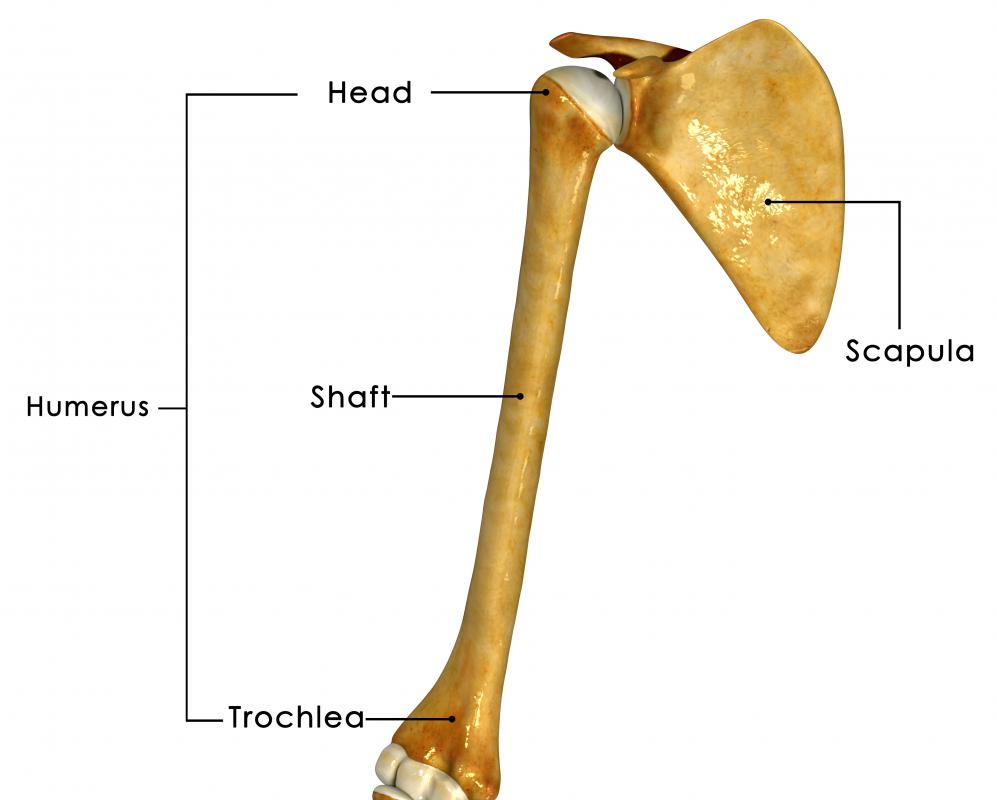At TheHealthBoard, we're committed to delivering accurate, trustworthy information. Our expert-authored content is rigorously fact-checked and sourced from credible authorities. Discover how we uphold the highest standards in providing you with reliable knowledge.
What is the Glenohumeral Joint?
The glenohumeral joint is commonly known as the shoulder joint. Typically, the humerus, or upper arm bone, meets the scapula, or shoulder blade, to form what is classed as a ball and socket joint. This is because the round, ball-shaped head of the humerus fits inside a shallow, socket-shaped cavity in the scapula known as the glenoid cavity. The arrangement permits a large range of motion, but at the same time the joint is not very stable, relying on the surrounding muscles and ligaments to hold everything together and prevent injury.
Generally, the head of the humerus and the inside of the glenoid cavity are covered in a tough, smooth tissue known as cartilage, which enables the surfaces to slide over one another. A lubricating fluid known as synovial fluid can be found in the space between the two. Although the socket part of the joint is shallow, the glenoid cavity has a rim made of a fibrous cartilage, effectively making it deeper. Surrounding the joint is a capsule which is quite thin and does not fit tightly. This allows the glenohumeral joint to move freely.
The group of muscle tendons known as the rotator cuff fuses with the joint capsule. This helps to give the joint some stability and protection. Sometimes the cuff can become damaged and is a frequent cause of shoulder pain.

A common problem is frozen shoulder, or adhesive capsulitis. This is where the shoulder joint capsule becomes thickened and full of fibrous tissue strands, making movement limited and painful. The cause is not always easy to determine, although it can result from rotator cuff injury or long periods of immobility.
The nerve supply to the capsule and ligaments means that the glenohumeral joint is responsive to injury. Typically, the surrounding muscles respond to pain by going into spasm, preventing joint movement, and stopping the discomfort. With some types of disease, such as arthritis or infection, a glenohumeral joint effusion may occur. This is where the joint lining produces excess fluid, which may show up as a swelling between the head of the humerus and the scapula.

Due to the many and varied movements carried out by the shoulder, joint stability may sometimes be compromised. This is why, of all the large joints, the shoulder is probably the one that is most commonly dislocated. Glenohumeral joint dislocation occurs if force is suddenly applied to the humerus so as to lever the head of the humerus down and rupture the capsule. This can happen during a fall where the arm is outstretched.
AS FEATURED ON:
AS FEATURED ON:















Discussion Comments
I was doing a move in physical therapy and felt my shoulder tear anterior, with sharp pain for a moment. I am 56. I did get in an automobile accident in 2010, where I was hit from behind and the impact made my left shoulder feel irritated and painful, especially in the AC joint.
The MRI showed a 30 percent tear, a glenoid effusion and muscle strain injury. The orthopedic surgeon told me I had nothing wrong for my age, and did not even have a tear. When I got the report, I was shocked; at least I was correct about the partial tear. Anyway, even on time release pain killer 15 mg, I wake up at night. The orthopedic surgeon in Phoenix, AZ said he could do nothing at all. It's very disturbing.
You need to take care of your joints better! I'm not saying don't participate in sports, but you can find sports that are safer for your shoulder joint. You can also go to physical therapy to try and strengthen it.
I have arthritis in this area which has been giving me a lot of glenohumeral joint pain. I'm scared out of my mind that I might have to get shoulder replacement because of it when I'm older. I'm doing my best to keep it under control with physical therapy and medications. I've really come to understand the importance of this joint in this short time period.
@ankara-- I don't think that your shoulder joint is "weak." Your arm bone probably just doesn't fit into the socket very well. So when it receives a hard blow, it pops out.
A friend of mine had the same issue and he did get surgery for it. I think what they do is they go in and tighten where the arm bone and the glenoid cavity interlock so that the bone doesn't move out of the socket so easily. I think it's an easy procedure, because my friend was all better and doing joint exercises in about a month.
If the bone keeps dislocating from the glenohumeral joint, it can cause serious damage to the nerves there. Then you will have pain for the long term and will have to have a more complicated surgery. So I suggest that you have this fixed as soon as possible before things get worse.
I'm in my mid thirties and I've dislocated my shoulder about four times until now! The first couple of times was when I was younger and doing wrestling in school. Then it happened again while playing football in college. The last one happened recently, while I was playing soccer with friends and fell on my shoulder.
I went to the emergency room where they "re-located" it. The pain was unbelievable! The worst I've ever had. I still have my arm in a sling and won't be able to use my arm another week.
I'm curious, do some people have a weak glenhumeral joint? Why does my shoulder keep dislocating? Is there something I can do to prevent this from happening again? The ER doctor said I can have surgery for it. I haven't spoken to my orthopedic about this yet, but I'm hoping that there is an alternative.
Post your comments